One mole of an ideal gas goes from an initial state A to final state B via two processs : It first undergoes isothermal expansion from volume V to 3V and then its volume is reduced from 3V to V at constant pressure. The correct P−V diagram representing the two process in (figure)
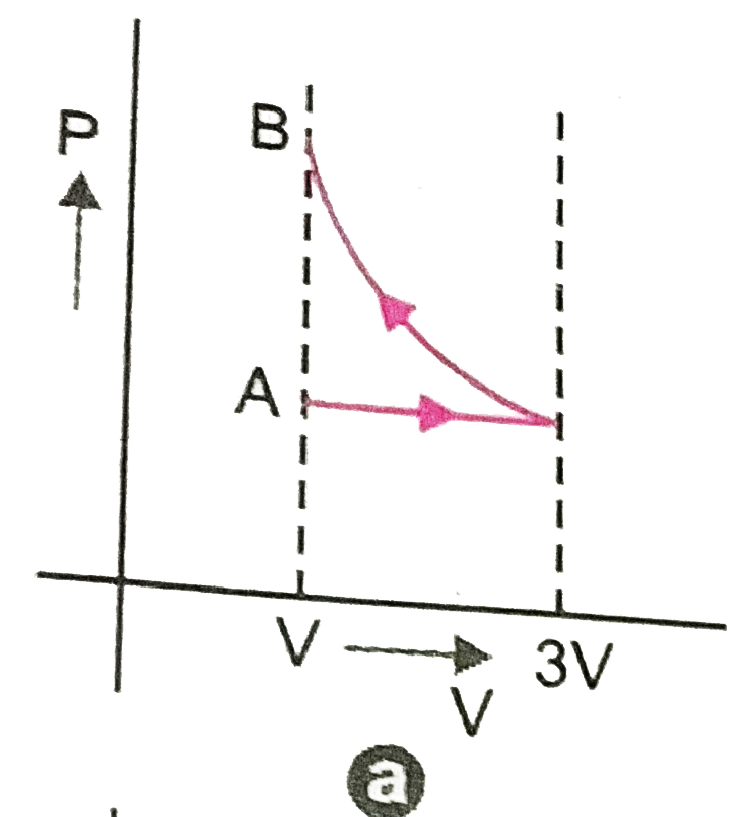
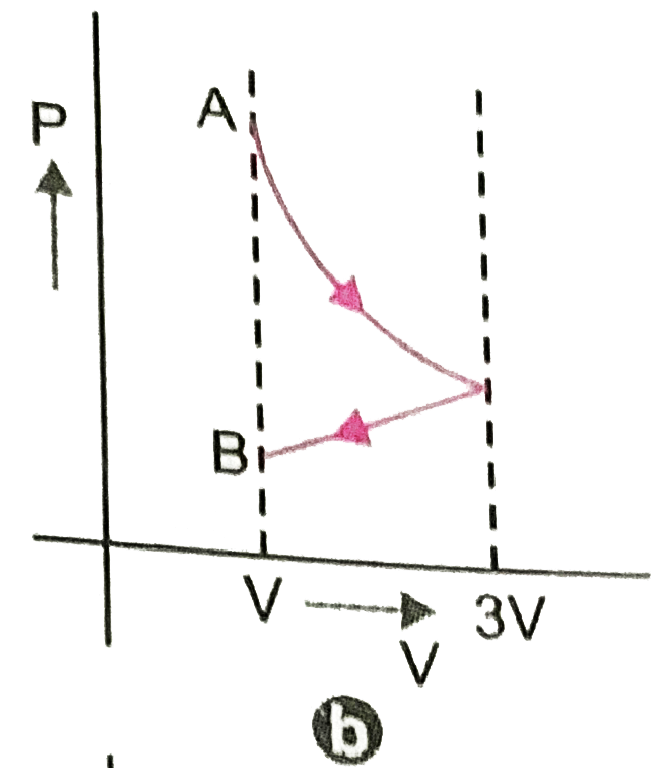
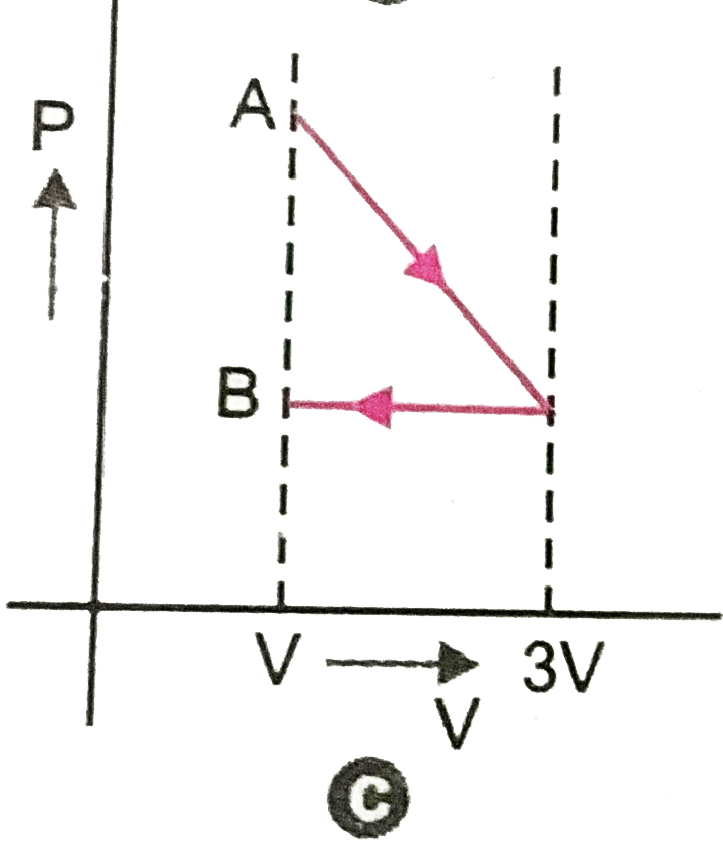
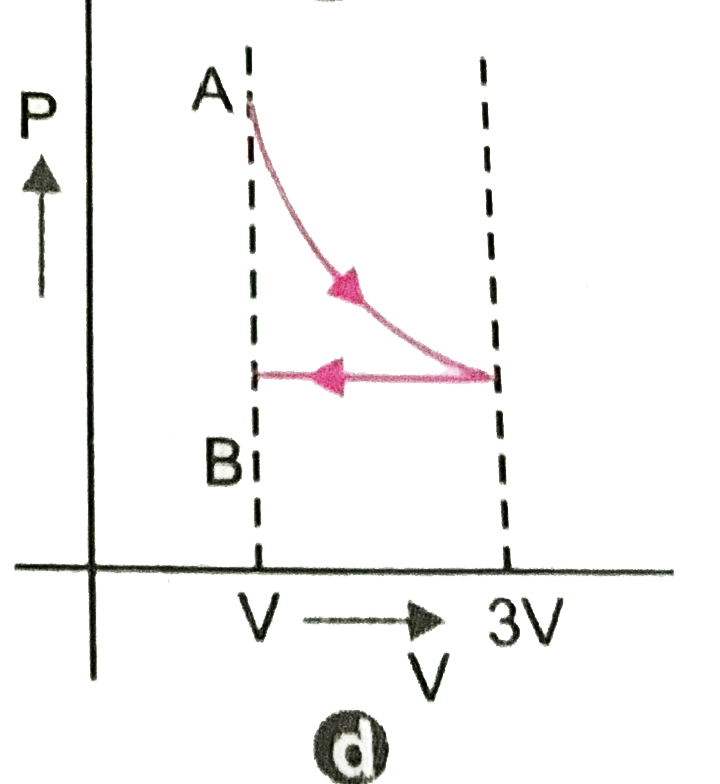
The correct Answer is:D
To solve the problem, we need to analyze the two processes that the ideal gas undergoes and how they are represented on a P-V diagram.
1. Identify the Initial and Final States:
- The initial state (A) is at volume V and some pressure PA.
- The final state (B) is at volume V after undergoing two processes.
2. Process 1: Isothermal Expansion:
- The gas undergoes isothermal expansion from volume V to 3V.
- During an isothermal process, the temperature remains constant, and we can use the ideal gas law PV=nRT. Since n and R are constants, P is inversely proportional to V.
- As the volume increases from V to 3V, the pressure decreases from PA to PB (where PB is the pressure at volume 3V).
- This process will be represented as a hyperbolic curve on the P-V diagram, moving from point A to point C.
3. Process 2: Isobaric Compression:
- After reaching volume 3V, the gas is compressed back to volume V at constant pressure.
- Since the pressure remains constant during this process, the line on the P-V diagram will be horizontal.
- This process will move from point C to point B.
4. Combine the Two Processes:
- The complete path from A to B on the P-V diagram consists of:
- A downward curve from A to C (isothermal expansion).
- A horizontal line from C to B (isobaric compression).
5. Identify the Correct P-V Diagram:
- Among the given options, we need to identify the one that shows a downward curve followed by a horizontal line.
- The correct option will be the one that represents the isothermal expansion followed by the isobaric compression.
Conclusion:
The correct P-V diagram representing the two processes is option D, which shows the isothermal expansion from V to 3V followed by isobaric compression from 3V back to V.
- The initial state (A) is at volume V and some pressure PA.
- The final state (B) is at volume V after undergoing two processes.
- The gas undergoes isothermal expansion from volume V to 3V.
- During an isothermal process, the temperature remains constant, and we can use the ideal gas law PV=nRT. Since n and R are constants, P is inversely proportional to V.
- As the volume increases from V to 3V, the pressure decreases from PA to PB (where PB is the pressure at volume 3V).
- This process will be represented as a hyperbolic curve on the P-V diagram, moving from point A to point C.
- After reaching volume 3V, the gas is compressed back to volume V at constant pressure.
- Since the pressure remains constant during this process, the line on the P-V diagram will be horizontal.
- This process will move from point C to point B.
- The complete path from A to B on the P-V diagram consists of:
- A downward curve from A to C (isothermal expansion).
- A horizontal line from C to B (isobaric compression).
- Among the given options, we need to identify the one that shows a downward curve followed by a horizontal line.
- The correct option will be the one that represents the isothermal expansion followed by the isobaric compression.
The correct P-V diagram representing the two processes is option D, which shows the isothermal expansion from V to 3V followed by isobaric compression from 3V back to V.
Topper's Solved these Questions
- THERMODYNAMICSBOOK - PRADEEPCHAPTER - THERMODYNAMICSEXERCISE - Interger Type questions
11 Videos
- THERMODYNAMICSBOOK - PRADEEPCHAPTER - THERMODYNAMICSEXERCISE - Assertion- Reason Type Questions
19 Videos
- THERMODYNAMICSBOOK - PRADEEPCHAPTER - THERMODYNAMICSEXERCISE - Multiple choice questions (NCERT)
10 Videos
- SYSTEMS OF PARTICLES AND ROTATIONAL MOTIONBOOK - PRADEEPCHAPTER - SYSTEMS OF PARTICLES AND ROTATIONAL MOTIONEXERCISE - Assertion- Reason Type questions
20 Videos
- WORK, ENERGY AND POWERBOOK - PRADEEPCHAPTER - WORK, ENERGY AND POWEREXERCISE - Assertion-Reason Type Questions
24 Videos
Similar Questions
Knowledge Check
One mole of an ideal gas goes from an initial state A to final state B via two processs : It first undergoes isothermal expansion from volume V to 3V and then its volume is reduced from 3V to V at constant pressure. The correct P−V diagram representing the two process in (figure)
A B
B C
C D
D
One mole of an ideal gas goes from an initial state A to final state B via two processes : It first undergoes isothermal expansion from volume V to 3V then its volume is reduced from 3V to V at constant pressure. The correct P-V diagram representing the two processes is
A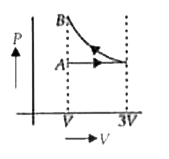 B
B C
C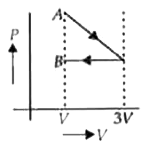 D
D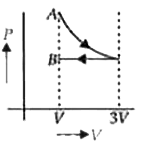
A gas at initial temperature T undergoes sudden expansion from volume V to 2V. Then -
AThe process is adiabaticBThe process is isothermalCThe work done in this process is nRT lne(2) where n is the number of moles of the gas.DThe entropy in the process does not change
Two moles of an ideal gas have an initial kelvin temperature Ti and absolute pressure Pi the gas undergoes a reversible isothermal compression from an initial volume Vi to a final volume 0.5 Vi
which one of the following expressions represents the final pressure of the gas ?
View SolutionP - V diagram of an ideal gas is shown. The gas undergoes from initial state A to final state B such that initial and final volumes are same. Select the correct alternative for given process AB.
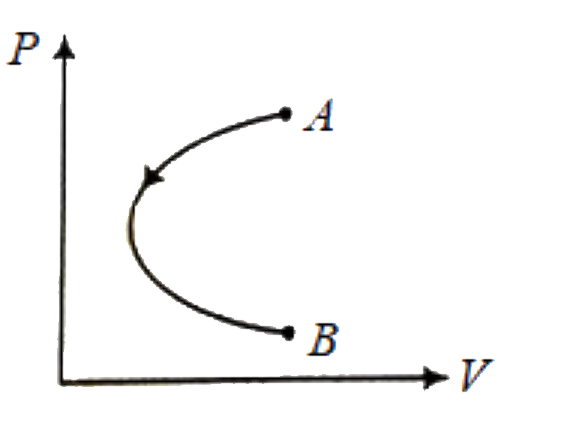
View SolutionThe initial state of certain gas (PiViTi).It undergoes expansion till its volume becomes Vf at constant temperature T. The correct plot of P-V diagram for it is
View SolutionTwo moles of an ideal gas have an initial kelvin temperature Ti and absolute pressure Pi the gas undergoes a reversible isothermal compression from an initial volume Vi to a final volume 0.5 Vi
How much heat is exchanged with the environment? If heat is exchanged, is it absorbed or released?
View Solutionn mole a perfect gas undergoes a cyclic process ABCA (see figure) consisting of the following processes.
A→B: Isothermal expansion at temperature T so that the volume is doubled from V1 to V2=2V1 and pressure changes from P1 to P2
B→C : Isobaric compression at pressure P2 to initial volume V1
C→A : Isochoric change leading to change of pressure from P2 toP1 .
Total work done in the complete cycle ABCA is :
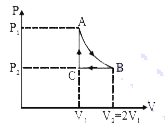
View Solution
